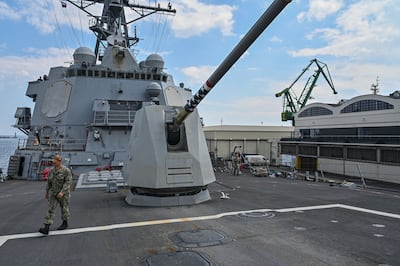Live updates: Follow the latest news on Israel-Gaza
A US warship came within seconds of being struck by a Houthi missile on Tuesday, officials said, underlining the dangerous threat that the well-armed Iran-backed militia poses to the US-led naval coalition in the Red Sea.
Four US officials told CNN that a “close-in weapon system”, better known as Phalanx, shot down the anti-ship missile around “one mile” (1.6km) from the USS Gravely.
Houthi cruise missiles such as the Al Mandeb 2 are thought to have a speed of around 1,100kph, or about 300 metres per second. If the missile was around 1.6km from the USS Gravely, as reported, it could have been as close as five seconds away from hitting the ship.
A direct hit on the warship could have led to the death of more US servicemen in the Middle East just days after three soldiers were killed in an attack in Jordan.
The region is on high alert as the spillover from the Israel-Gaza war threatens to escalate into a regional war between the US and Iran and its allies, including the Houthis in Yemen and Iraqi militias such as the one that claimed the attack in Jordan.
This latest incident in the Red Sea could have further stoked tensions if the USS Gravely's Phalanx system had not kicked in.

US naval defences
The Phalanx system is the last line of defence for US warships and aircraft carriers.
It consists of a Gatling gun that can fire a stream of 4,500 shells per minute to a range of around 3km.
Phalanx spots low-flying missiles with a high-resolution infrared camera that detects heat from their engines and two radar systems, one that detects a missile at distance and one that tracks it at close range, sending data to its gun.
In ideal conditions, warships in a US carrier group are protected by several layers of early-warning systems before they resort to using the Phalanx.
These range from satellites that can detect missile launches and calculate the intended target and type of missile, to airborne and ship-based early-warning and detection systems.
The satellites monitoring thermal radiation on Earth will relay launch positions to US missile defences, while E-2 Hawkeye early-warning aircraft radar can detect cruise missiles flying low over the sea several hundreds of kilometres from their target.
Available fighter jets can then be directed to shoot the missiles down with AIM-9X air-to-air missiles; US F-18 Super Hornets appear to have been used in this role during the multinational Operation Prosperity Guardian.
If the missile closes in, warships can detect its built-in guidance radar, before the Aegis Combat System, which can track 100 targets, simultaneously “illuminates” the missile with its SPY-1 radar, which is carried by the USS Gravely.
Warships can then fire advanced SM-6 missiles – costing nearly $5 million each – at the inbound threat, destroying it many hundreds of kilometres away. In a test in 2014, a cruise missile was “killed” by the SM-6 at 800km.
If this fails, the ships can fire Evolved SeaSparrow missiles, which have a range of around 50km but according to the US, interceptions at around 10km are common.
Warships can also use a combination of decoy drones to confuse the missile’s on-board radar, which actively seeks ships to target, or the Phalanx system at the final line of defence.
It’s unclear why the above measures failed until the last line of defence. However, on Wednesday the Houthis said they had launched a volley of missiles at a commercial vessel, the Liberian-flagged KOI, suggesting the group can still launch multiple projectiles to overwhelm US defences.
The Houthis have continued attacks against vessels in the Red Sea despite US and UK air strikes on the group's military sites in Yemen.
Their campaign against shipping has caused major disruption to global trade, forcing international shipping companies to reroute cargo ships away from the waterway.





